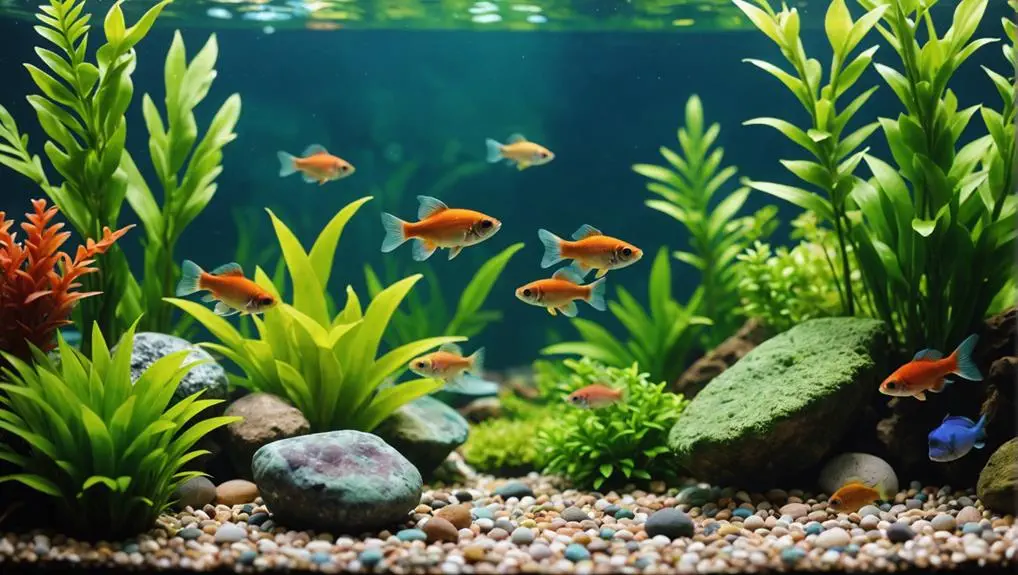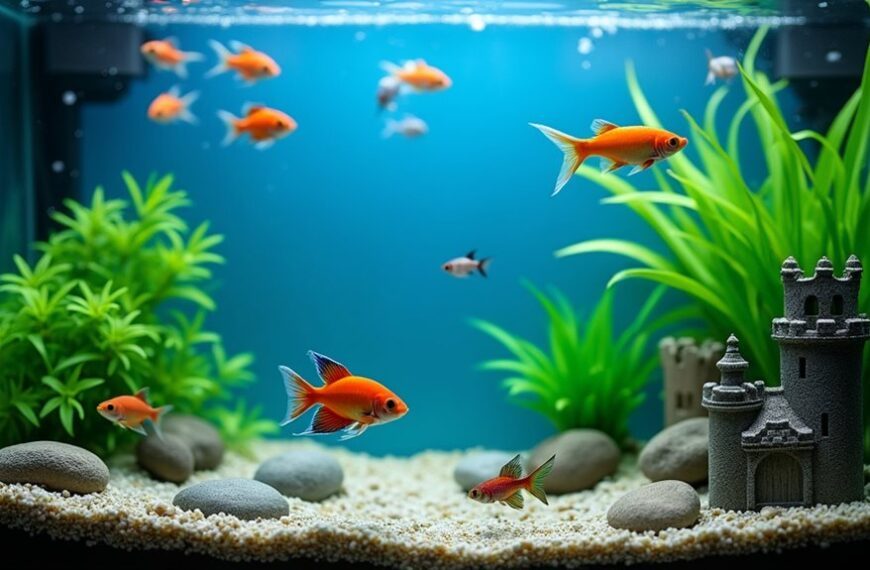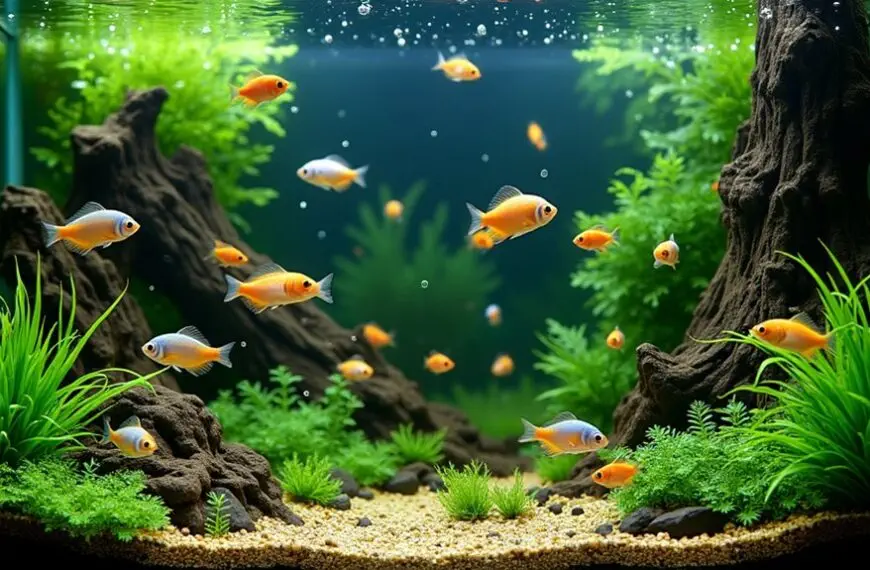Starting your aquarium adventure doesn't have to be pricey! You can consider options like goldfish, bettas, and guppies. Goldfish are low-maintenance but need a good-sized tank, while bettas bring color and personality to your setup, just remember they're a bit territorial. Guppies are lively little fellows that thrive in groups, making them great for social interactions. Don't forget about neon tetras, zebra danios, or even cherry barbs for extra vibrancy. Each fish offers unique traits and brings joy to your underwater world. Keep exploring, and you'll discover even more fascinating options for your tank!
Contents
Goldfish
Goldfish are a fantastic choice for anyone looking to start an aquarium. These low-maintenance, hardy fish are perfect for beginners, and with proper care, they can grow impressively large, reaching lengths of 12 to 14 inches.
As they're known for their resilience and adaptability, you'll need at least 30 gallons of water per fish, so plan accordingly! ideal tank conditions are essential for their health and happiness.
Goldfish come in different varieties like comet, shubunkins, and sarasa, all known for their adaptability. However, they're significant waste producers, so keeping up with regular water changes is crucial to maintain good water quality.
Trust us, your goldfish will thank you for it by swimming happily!
When it comes to their diet, focus on a mix of spirulina algae, veggies, and low-protein foods. Transitioning to pelleted diets can help manage waste, making your life a little easier.
While you might dream of a community aquarium, it's best to keep goldfish in single-species tanks to prevent stress and territorial squabbles.
Betta Fish
When considering vibrant and interactive additions to your aquarium, betta fish (Betta splendens) are hard to beat. These colorful fish not only brighten up your fish tank but are also easy to care for, making them an excellent choice for beginner fish enthusiasts.
To keep your betta happy and healthy, aim for a tank size of at least 5 gallons. Maintaining a stable environment with ideal tank conditions will greatly enhance their wellbeing. Don't forget a filter and heater, as the ideal water temperature for bettas ranges from 78-82°F.
Now, while male bettas can be a bit territorial, they thrive best alone or with non-aggressive fish. On the other hand, females can share a space in small groups, provided they're introduced carefully.
You'll love learning about their quirky behaviors, like bubble nesting during breeding—it's a real showstopper!
Feeding your betta is straightforward too. They enjoy betta-specific pellets, but feel free to treat them occasionally with freeze-dried bloodworms or brine shrimp.
Just remember, sharp decorations can hurt their delicate fins, so choose wisely!
With the right setup and care, your betta fish won't only survive but thrive, becoming a delightful companion in your aquatic adventure.
Guppies
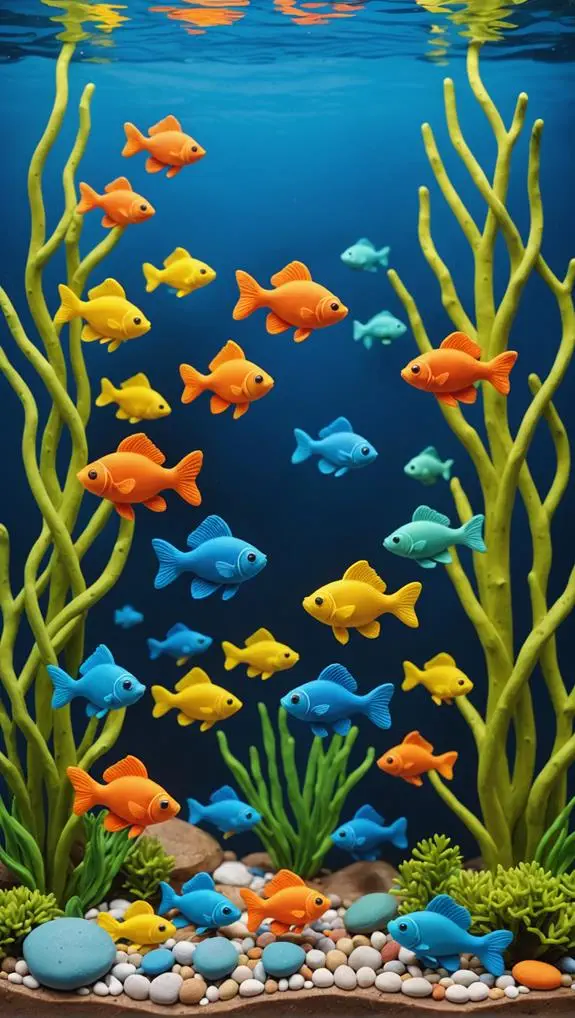
Guppies (Poecilia reticulata) are a fantastic choice for any aquarium, especially if you're looking to add a splash of color and life.
These little beauties are perfect for beginners, thanks to their small size and peaceful nature. Guppies are also known for their hardiness and adaptability, which makes them ideal for easy care requirements, whether you're a seasoned aquarist or a newbie.
Here are a few reasons why guppies are great:
- Live-bearing fish: They give birth to live young, making breeding an exciting possibility.
- Active fish: Guppies are always on the move, bringing energy to your tank.
- Minimal care requirements: Their adaptability to various water conditions means they're low-maintenance.
Guppies thrive in groups of five or more, so make sure to keep them in a cozy community.
They prefer water temperatures between 68-78°F and a pH of 6.5-8.0. With their varied diet of flakes, pellets, and occasional greens, you won't have to worry too much about feeding.
If you're looking for your first fish, guppies are an excellent choice that'll brighten your aquarium and warm your heart!
Neon Tetras
Neon tetras (Paracheirodon innesi) are a stunning addition to any aquarium, thanks to their vibrant blue and red hues that catch the eye. These small schooling fish typically grow to about 1.5 inches and are perfect for community tanks.
You'll find their peaceful nature makes them a delight to watch, especially when they swim in groups of at least six. Caring for neon tetras is quite easy, which is why they're often chosen as fish for beginners.
They thrive in a variety of conditions, preferring water temperatures between 70-81°F and a pH of 6.0-7.0. A well-planted aquarium setup helps them feel secure and comfortable, so don't skip on those aquatic plants!
Plus, their vibrant colors add a splash of joy to your tank, making you feel like a proud aquarium owner. These fish species get along well with others, making them a fantastic choice if you want to create a lively community.
Cory Catfish
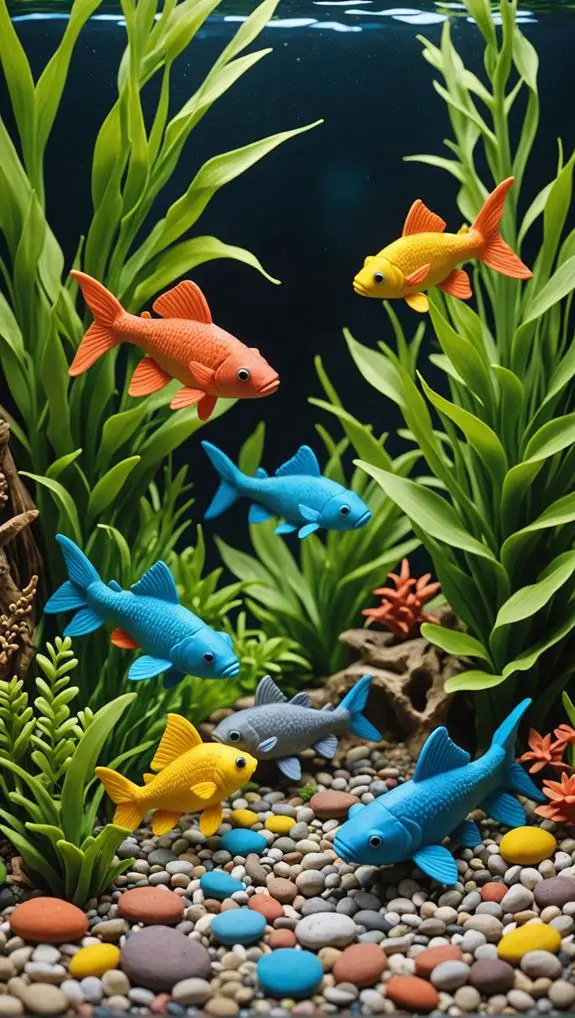
If you're looking to enhance your aquarium with more bottom-dwellers, Cory catfish are a fantastic choice. These peaceful little fish are perfect for community tanks and thrive in groups of at least five. Imagine watching them school together while foraging for food—it's quite a sight!
Here are a few reasons why you'll love adding Cory catfish to your tank:
- They grow only between 2 to 4 inches, making them ideal for small tanks.
- Common varieties like albino, bronze, and panda cory each have unique colors and patterns that brighten up your aquarium.
- They adapt well to different water conditions, so they're easier to care for than others.
Cory catfish have sensitive barbels, so be sure to provide a soft substrate to protect them. Their diet should include sinking pellets, algae, and detritus.
With their hardy nature, they'll thrive in temperatures between 72-82°F and a pH of 6.5-7.8. Plus, their social antics will keep you entertained!
Platies
For anyone looking to add vibrant life to their aquarium, platies are an excellent option. These delightful little fish, reaching about 3 inches, are perfect beginner pets. They boast robust health and adapt well to different water conditions, making them a breeze to care for. You won't have to worry too much about water pH since they thrive in a range of 7.0 and prefer moderately hard water.
Platies are omnivorous, so feeding them is simple! Just toss in some community fish food—flakes, pellets, or even a bit of plant material—and watch them go.
These social fish love to hang out in groups of at least three, showcasing their lively behaviors and colorful patterns. You'll find platies in a variety of color variations that can brighten up your tank and put a smile on your face.
Not only are platies stunning, but they're also an affordable choice for new aquarium owners. You get a lot of bang for your buck with these charming fish, and they'll surely bring joy to both you and your tank!
Cherry Barbs
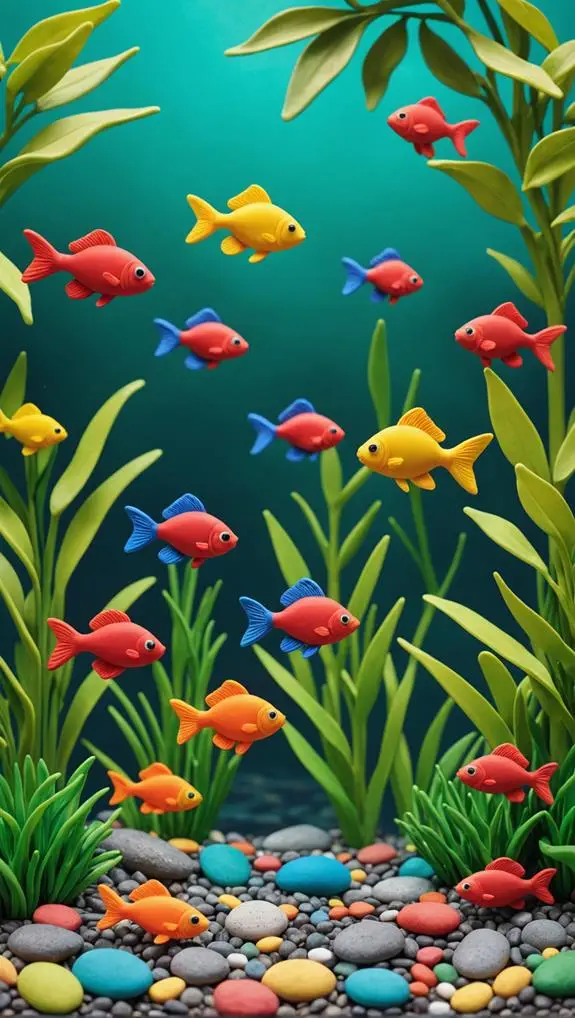
Cherry Barbs are a fantastic choice if you're looking for peaceful fish that love to school together.
These little guys thrive in cozy groups of 5-6 and prefer a comfy tank temperature between 74-80°F.
Plus, with their vibrant colors and easy care needs, you'll find they're not just beautiful but also a breeze to maintain!
Peaceful Schooling Behavior
When you keep cherry barbs in your aquarium, you'll quickly notice their peaceful schooling behavior, which thrives in groups of at least 5-6 individuals. These vibrant little fish are truly a delight, especially when they swim together, showing off their beautiful colors.
Here's what makes cherry barbs an excellent choice for your community tank:
- Social Butterflies: They enhance the atmosphere and feel of your aquarium.
- Active Swimmers: They love to explore and dart around, bringing life to your tank.
- Hiding Spots: Providing plants and decorations gives them a sense of security.
Cherry barbs are peaceful schooling fish, making them perfect companions for other gentle species. They prefer an appropriate tank size to ensure they've enough room to roam and interact.
Plus, they adapt well to various water conditions, thriving in temperatures between 74-80°F and a pH of 6.0-7.0.
Ideal Tank Conditions
Creating the right environment is crucial for keeping cherry barbs happy and healthy in your aquarium. These delightful freshwater fish thrive in temperatures between 74-80°F and prefer a pH level of 6.0-7.0. You'll want to create ideal tank conditions that allow them to flourish.
Start by ensuring you have a minimum group of 5-6 cherry barbs, as they're peaceful schooling fish that feel more secure in numbers. A heavily planted tank with plenty of hiding spots will make them feel right at home and encourage their natural behaviors.
Don't forget about maintaining water quality! Regular water changes and monitoring water quality are essential, as cherry barbs are sensitive to poor conditions.
You'll also want to provide a varied diet, including high-quality flakes and occasional live or frozen foods. This helps support their health and vibrant colors—who doesn't love a splash of color in their aquarium?
Care and Maintenance Tips
To keep your cherry barbs thriving, proper care and maintenance are key. These little beauties are among the best aquarium fish for beginners, known for their vibrant colors and easy-to-keep nature.
Here are some essential care and maintenance tips:
- Tank Size: Aim for at least a 20-gallon tank to provide ample swimming space.
- Water Changes to Keep: Regularly change 10-15% of the water weekly to maintain good tank conditions and prevent disease.
- Feeding Fish: Feed them a varied diet of high-quality flake food, vegetable matter, and occasional protein supplements.
Zebra Danios
If you're looking for lively additions to your aquarium, Zebra Danios are a fantastic choice!
These hardy little fish not only bring a splash of color with their striking stripes but also thrive in a variety of water conditions, making them super easy to care for.
Plus, they love to hang out in groups, so get ready to watch them zip around together like they're at a fishy party!
Hardiness and Adaptability
Resilience is a key trait of zebra danios (Danio rerio), making them a favorite among beginner aquarists. These small fish, growing to about two inches long, are perfect for those just starting out in keeping fish. Their hardiness and adaptability shine through, allowing them to thrive in various water conditions without needing a heater. Talk about low maintenance!
Here are a few reasons why zebra danios make great beginner pets:
- They can withstand temperatures from 64°F to 75°F.
- They're resilient to common fish diseases, simplifying care.
- They prefer to swim in groups, so a number of fish is essential for their happiness!
With their vibrant colors and active nature, zebra danios not only add visual appeal to a good tank but also keep the environment lively.
Plus, since they do well in smaller community tanks, you won't need an extensive setup. Just remember, these fish are easy to care for, making your aquarium journey enjoyable and rewarding.
Social Behavior Requirements
Zebra danios thrive in social settings, making them a joy to keep in your aquarium. These lively little fish grow to about three inches in length and truly shine when kept in schools of at least 5-8 individuals. Their active and playful nature brings a spark to your tank, as they dart around with dynamic swimming patterns that'll keep you entertained.
When you're choosing tank mates, zebra danios are fantastic community fish. They're generally peaceful and get along with various compatible freshwater species, as long as you avoid overly territorial types.
To help your zebra danios flourish, you should create an environment with ample swimming space and plenty of hiding spots. This setup encourages their natural social behavior and keeps them happy.
Plus, keeping your tank clean will ensure they thrive. These hardy fish are easy to care for and adapt well to a range of water conditions, making them a great choice for new aquarium owners.
Harlequin Rasboras
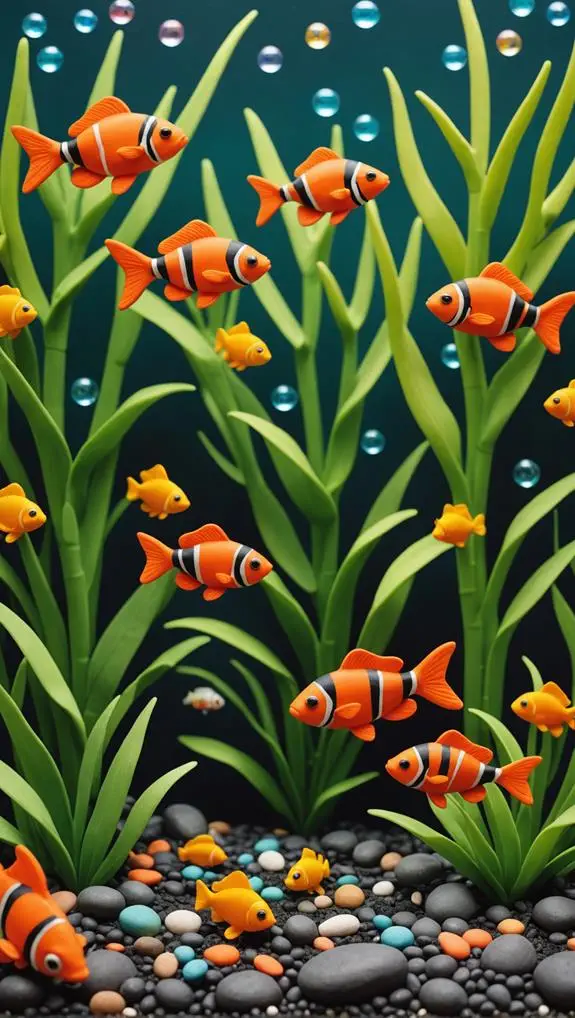
Harlequin Rasboras are a fantastic choice for any aquarium owner looking to add lively and colorful fish to their community tank. These small, peaceful fish reach about 2 inches in adult size and thrive in groups, displaying beautiful schooling behavior. Their vibrant pinkish-beige bodies adorned with striking black triangular markings make them a delightful addition.
Here are a few reasons why Harlequin Rasboras make great beginner pets:
- Easy Care: They adapt well to various water conditions, preferring slightly acidic to neutral pH levels.
- Peaceful Nature: They get along well with other fish, like tetras and corydoras, enhancing your community tank's harmony.
- Simple Feeding: Their diet consists of readily available small flakes, pellets, and even live foods.
With a bit of attention to their needs, you'll find that these charming fish not only brighten up your aquarium but also bring a sense of calm. Watching them swim together can be a joyful experience, and it's a fun way to enhance your aquatic environment.
Kuhli Loaches
Kuhli loaches are some of the coolest little fish you can add to your aquarium; their eel-like shape and playful nature make them stand out.
You'll love watching them scurry around at night, but remember they prefer a soft substrate to keep their delicate bodies safe.
Plus, they're peaceful buddies that help clean up your tank, so they fit right in with a variety of other fish!
Unique Appearance and Behavior
A fascinating addition to any aquarium, kuhli loaches are small, eel-like fish that captivate with their unique appearance and behavior. These little guys typically grow to about 4 inches long and have a sleek, elongated body that resembles an eel. Their shy behavior means they're happiest when kept in a group of three to six, so don't just bring home one!
Here are some fun facts about kuhli loaches:
- They're nocturnal scavengers, often foraging at the substrate level.
- They thrive in well-planted tanks with plenty of hiding spots, like caves or dense vegetation.
- Kuhli loaches are peaceful and get along well with other community fish.
These charming fish not only add an interesting look to your aquarium but also help keep it clean by munching on leftover food and detritus.
Watching them dart out from their hiding spots can be quite entertaining!
Just remember, they prefer a cozy, well-planted environment to feel secure.
Care and Maintenance Tips
Creating a thriving habitat for kuhli loaches requires attention to their specific needs and preferences. These popular pet fish grow up to about 4 inches and thrive in groups of three to six. This social behavior makes them feel more confident in your freshwater aquarium.
Since they're nocturnal, you'll want to add plenty of hiding spots with plants and decorations, giving them a cozy place to retreat during the day. A soft substrate is crucial, as it allows these bottom-feeding fish to burrow comfortably, reducing stress.
Regarding fish food, offer a balanced diet that includes high-quality sinking pellets, live or frozen foods, and occasional treats to promote a healthy lifestyle. Regular tank maintenance is key! Keep an eye on water quality, aiming for a pH range of 6.0 to 7.5.
Regular water changes help maintain those conditions and keep your kuhli loaches happy. With a little dedication and the right information on caring for these fish, you'll find that they're not just easy to breed but also a delightful addition to your aquarium.
Frequently Asked Questions
What Is the Best Starter Fish for a New Aquarium?
When choosing starter fish for your new aquarium, consider guppy fish, neon tetras, or platies. They're colorful and easy to care for. Just ensure you research fish compatibility and specific care needs to succeed.
What Is the First Fish to Put in a New Aquarium?
When starting your aquarium adventure, consider hardy fish like zebra danios. They thrive in varied tank parameters, helping ease stress while you stabilize water chemistry. Introduce them carefully, ensuring fish compatibility and mindful of feeding habits.
What Is the Best Fish to Add to a New Tank?
When adding fish to your new tank, consider fish compatibility, tank size, and water parameters. Ensure their feeding habits align, respect social behavior, and maintain aquarium decor for disease prevention and long-term care success.
What Are the Best Low Maintenance Fish?
Think of a harmonious community tank, where hardy freshwater fish thrive together. Choose easy-going tank mates like guppies or zebra danios; they adapt well, meet basic diet needs, and maintain peaceful behavior traits while enriching your aquarium.
Final Thoughts
So, there you have it! You're all set to dive into the colorful world of aquarium fish. Whether you choose a vibrant Betta or a playful Guppy, each fish brings its unique charm. Remember, setting up an aquarium can feel like a rollercoaster ride, but with these affordable options, you won't break the bank. It's all about finding what makes you smile. So, grab your gear, and let your aquatic adventure begin—it's gonna be a splash!

